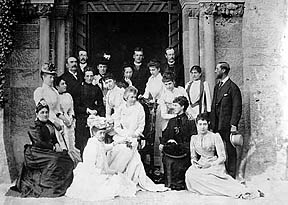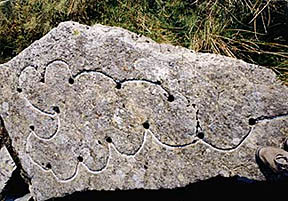|
Celebrations and Visitors
|
‘If you wish to see nature and art
intermarried…go and view the Penrhyn Quarry and the Britannia and
Menai Bridges.’
(Yr Herald Cymraeg, May 15, 1869.)
|
 It is probable that the slate
quarries were some of the first tourist attractions. Indeed, by
1910 a shop was selling souvenirs made out of slate by the
entrance to the Penrhyn Quarry. Visitors from far and wide came
to view the industrial wonders. And whenever a royal personage
came or an important local celebration to mark, rock
cannon were fired. This was not unique to the quarry
producing areas. Rock cannon were fired at the Parys Copper Mines
at Amlwch, but they were found also in many other industrial
areas on mainland Europe. The tradition in Wales dates back to
the mid eighteenth century it appears. It is probable that the slate
quarries were some of the first tourist attractions. Indeed, by
1910 a shop was selling souvenirs made out of slate by the
entrance to the Penrhyn Quarry. Visitors from far and wide came
to view the industrial wonders. And whenever a royal personage
came or an important local celebration to mark, rock
cannon were fired. This was not unique to the quarry
producing areas. Rock cannon were fired at the Parys Copper Mines
at Amlwch, but they were found also in many other industrial
areas on mainland Europe. The tradition in Wales dates back to
the mid eighteenth century it appears.
 In
Gwynedd up to December 2001, 235 such sites have been located
with 6,157 firing holes to them. In
Gwynedd up to December 2001, 235 such sites have been located
with 6,157 firing holes to them.
Boring holes into suitable smooth rocks formed the rock
cannon. These holes were on average 125 mm in depth and between
25 mm and 32 mm in diameter. The holes were linked to each other
in the earliest instances with smearing of goose grease. And
before the invention of the safety fuse goose quills were
used.
Later on a channel would be gouged out starting from the first
hole and linking each one. Around 57 gms of black powder would be
placed in each hole. Powder would also be placed in the
channels.
There is plenty of evidence to rock cannon being fired. They
were heard in 1859 when Victoria and Albert paid a visit to Castell Penrhyn, when Queen Elizabeth of
Roumania came in 1890 and when Albert Edward and his family came
to Penrhyn as part of their visit to the National Eisteddfod of
1894. This was probably the greatest royal binge of all times in
the area.
George William Duff Assheton-Smith, heir to the Faenol
estate, came of age in 1869 and great were the rejoicings.
|